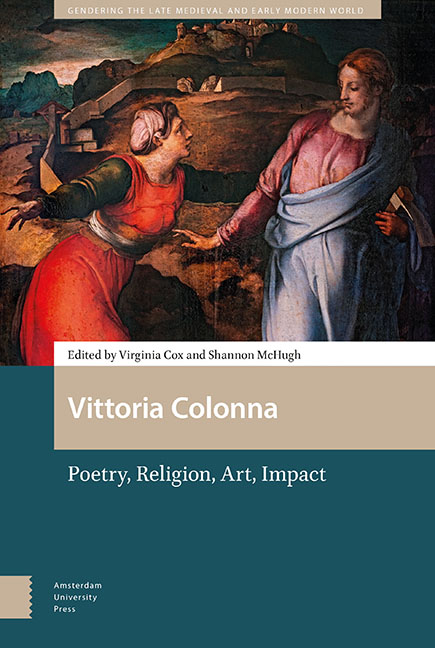Book contents
- Frontmatter
- Dedication
- Contents
- List of Illustrations
- Acknowledgements
- Introduction: The Twenty-First Century Vittoria Colonna
- Part 1 Literary and Spiritual Sociability
- Part 2 Widowhood
- Part 3 Poetry
- Part 4 Art
- Part 5 Readership
- Part 6 Impact
- Volume Bibliography
- Index of Citations of Colonna’s Letters and Verse
- Thematic Index
1 - The D’Avalos-Colonna Literary Circle: A ‘Renewed Parnassus’
Published online by Cambridge University Press: 16 December 2021
- Frontmatter
- Dedication
- Contents
- List of Illustrations
- Acknowledgements
- Introduction: The Twenty-First Century Vittoria Colonna
- Part 1 Literary and Spiritual Sociability
- Part 2 Widowhood
- Part 3 Poetry
- Part 4 Art
- Part 5 Readership
- Part 6 Impact
- Volume Bibliography
- Index of Citations of Colonna’s Letters and Verse
- Thematic Index
Summary
Abstract
This study examines the various links between the Neapolitan Accademia Pontaniana and the d’Avalos-Colonna literary gatherings on the island of Ischia, arguing that the former figured as intellectual ancestor of the latter. The two informal groups shared a common geographical context—the bay of Naples—as well as striking similarities between their leading figures, Giovanni Pontano and Vittoria Colonna. This analysis is based mainly on literary sources such as Girolamo Britonio's Gelosia del Sole and Paolo Giovio's Dialogus de viris et foeminus aetate nostra florentibus, which make reference to both explicit and subtle connections between the Ischian cenacolo—often referred to in terms of Parnassus—and its inspirational father figure, the original Accademia Pontaniana.
Keywords: sodality, salon, humanists, literary circles, Parnassus, intellectual lineage, intellectual genealogy
During the first decades of the sixteenth century—a period of political and religious turmoil in Italy—two women, Costanza d’Avalos, the chatelaine of the castle of Ischia, and her niece by marriage, Vittoria Colonna, hosted literary gatherings on Ischia. This cenacolo, or coterie, a rich subject for scholarship, has been studied only partially up until now. Scholars have noted its role as an intellectual and spiritual milieu of Colonna and its function as a refuge for intellectuals and poets forced to leave their homes, on account of political or physical threats. It has also been emphasized that the d’Avalos-Colonna circle was one of the first examples of a cenacolo run by women. It is interesting to note, in this connection, that female scholars dominated twentieth-century work in this area, notably Amalia Giordano (1906) and Suzanne Thérault (1968). Giordano established the division of the d’Avalos-Colonna cenacolo into four periods: the first (1509–12) in which Jacopo Sannazaro, Benedetto Gareth (‘Cariteo’) and a few other poets participated; the second (1517–25), featuring Galeazzo di Tarsia, Girolamo Britonio and Jacopo Campanile (‘Capanio’); the third (1527–28), seeing the participation of Giano Anisio, Paolo Giovio, Marcantonio Minturno and Marcantonio Flaminio; and the last period (1533–36), when Bernardo Tasso, Luigi Tansillo, Angelo di Costanzo and Berardino Rota were members of the circle. Therault subsequently modified Giordano's division by amalgamating the first and second periods to a single period from 1509–25, in which Sannazaro was the leading figure. This framework has proven more productive.
- Type
- Chapter
- Information
- Vittoria ColonnaPoetry, Religion, Art, Impact, pp. 37 - 54Publisher: Amsterdam University PressPrint publication year: 2021



